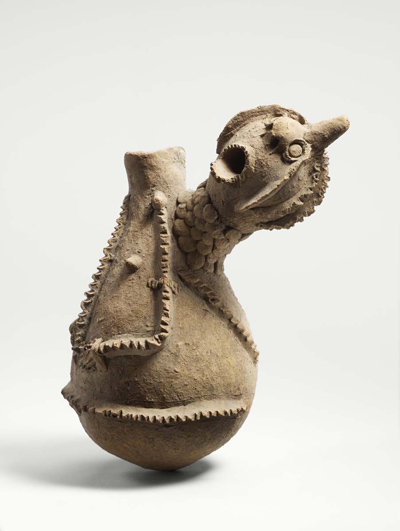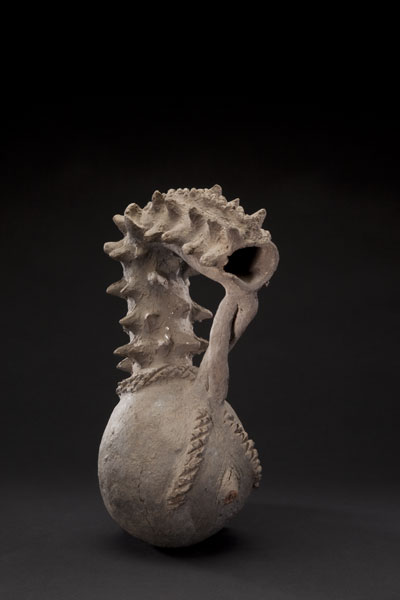
|
|||

|
|

Knowledge of Benue Arts | The Lower Benue: Fluid Artistic Identities | The Middle Benue: Visual Resemblances, Connected Histories | The Upper Benue: Expressive and Ritual Capacities of Clay | Curriculum Resource for Central Nigeria Unmasked (pdf - Link to Fowler web site)  Due to its relative isolation, the Upper Benue is distinct from other areas of the river valley. Its rugged, hilly terrain provided shelter from the incursions of invading groups, especially mounted Fulani warriors. The remoteness of the region also meant that local ritual practices were able to persist well into the late twentieth century when they were documented in the field. The predominance of sculptural ceramic vessels at the center of Upper Benue religious practices represents a marked departure from the wood figures and masks typical of the other two subregions. The highly decorated and anthropomorphized vessels, made primarily by women artists, instead exploit the expressive capacities of clay. Like wood sculpture, ceramic vessels served various ritual functions, including healing the sick, safeguarding hunters and warriors, and activating the presence of various ancestral and protective spirits. Here, as elsewhere, there are striking convergences in the styles and functions of ceramic sculpture mapped among neighboring peoples, revealing the extent of their historical communication and exchange. In a stunning deviation from the norm, monumental male figures carved in wood may be the only vestiges of an abandoned memorial tradition that persisted primarily in clay.  Vessel to protect a pregnant woman and her fetus (jina bitibiyu) Cham-Mwana peoples Late 20th century Ceramic Musée du quai Branly, Paris, 73.1998.12.6 L2010.40.14 © 2010. Musee du quai Branly_Photo Thierry Ollivier/Michel Urtado/ Scala, Florence This vessel type is idiosyncratic, built with a "blind-spout" in the form of an open-mouthed head emerging at a diagonal from the side of the vessel. It was used by women to protect the fetus or to cure illnesses associated with pregnancy.  Musa Rabkabaw (active 1950s-1970s) Spirit vessel (Ngwarkandangra) 'Bǝna peoples, Riji village Circa 1955 Ceramic Fowler Museum at UCLA; Gift of Arnold Rubin Collected by Arnold Rubin, 1970 X86.4693 Photograph by Don Cole, 2010. © Fowler Museum at UCLA The elegant twisted beard on this example is unusual and may be an innovation by the artist, Musa Rabkabaw, who created it. |
|
 Back to: NMAfA past exhibits |
|||